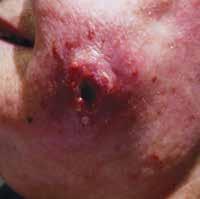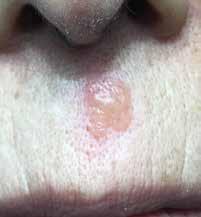
3 minute read
DERMATOLOGY
by FloridaMD
Things That May Look Malignant But Are Not
By John “Lucky” Meisenheimer, MD and John Meisenheimer, VII
Advertisement
Abscess – not an ulcerated squamous cell carcinoma.
The rate of the number of skin biopsies performed each year nationally has increased by about 6% a year for the last ten years or so. Part of this increase appears to be due to physician extenders biopsying more lesions. The good news is that although there may be more unnecessary biopsies, we have also had an increase in early detection of melanoma in situ, so overall, we are still saving lives. The difficulty is that there are many benign lesions to the untrained eye that look suspicious for skin cancer. Often, for a trained dermatologist, it is simple to tell benign from malignant lesions. Still, in some cases, it is far more problematic, and a biopsy is needed to make sure you are not missing something important.
In my practice, I never tell a patient, we will “closely watch” something suspicious to see if it looks worse in 6 months. I have had patients on their visits with me point out lesions that their health care provider is “following” as it appeared a little suspicious to them. If it is questionable, then it needs to be biopsied, period, now, not in 6 months when it has had a chance to grow. You only follow lesions that don’t look suspicious. If I am at all suspicious, and of course, being a dermatologist, I have the advantage of intuitive expertise, I will biopsy, and I like other dermatologists have a high rate of success in finding the spots that do need biopsying.
There are times that I will biopsy a spot just because I have an inkling of a thought that there might be something going on; this is the intuitive expertise kicking in again. Sometimes I biopsy lesions because it is a CTA (Cover Thy Ass) moment. Although I know deep in my heart that the spot is benign, it sure looks funky, and I want to make sure I have not made a mistake. Better to biopsy and prove yourself wrong than trying to explain to the jury why not biopsying the malignancy that appeared benign, was the correct choice, good luck with that challenge.
What about a growth that looks completely benign, but you are mistaken? If I feel that there is nothing clinically wrong with a lesion, I will explain to the patient, “if it should change or become symptomatic, then come back in for a recheck, do not wait for your six or twelve months follow up.” If you don’t give the patients this bit of sage advice, then you will invariably see the following scenario happen.” A patient calls three years after his last exam. “Doc, I had a spot you said was okay, but it started growing about a week after I saw you. I didn’t do anything as you said it was okay. It’s now about the size of a golf ball, do you think I need to come in, it’s been three years now and still growing, what do you think?”
Benign appearing lesions that, in reality, have gone to the dark side will eventually evolve. The patient will be the first to notice this happening, and they need to know you take changes seriously, even if it occurs days or weeks after their exam. Return checks on sudden changes in benign-appearing growths are your security net for wolves hiding under sheepskins.

Hidrocystoma - not Merkel cell carcinoma.

Chondrodermatitis – not Squamous cell carcinoma.
Herpes – not Basal cell carcinoma.
Lucky Meisenheimer, M.D. is a board-certified dermatologist specializing in Mohs Surgery. He is the director of the Meisenheimer Clinic – Dermatology and Mohs Surgery.
John Meisenheimer, VII is a medical student at USF.



